William T. Freeman
Large Video Planner Enables Generalizable Robot Control
Dec 17, 2025

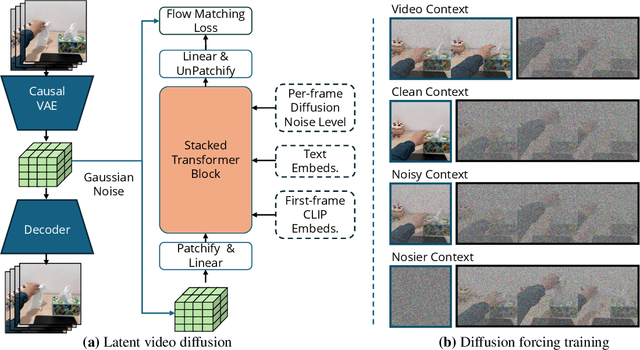

Abstract:General-purpose robots require decision-making models that generalize across diverse tasks and environments. Recent works build robot foundation models by extending multimodal large language models (MLLMs) with action outputs, creating vision-language-action (VLA) systems. These efforts are motivated by the intuition that MLLMs' large-scale language and image pretraining can be effectively transferred to the action output modality. In this work, we explore an alternative paradigm of using large-scale video pretraining as a primary modality for building robot foundation models. Unlike static images and language, videos capture spatio-temporal sequences of states and actions in the physical world that are naturally aligned with robotic behavior. We curate an internet-scale video dataset of human activities and task demonstrations, and train, for the first time at a foundation-model scale, an open video model for generative robotics planning. The model produces zero-shot video plans for novel scenes and tasks, which we post-process to extract executable robot actions. We evaluate task-level generalization through third-party selected tasks in the wild and real-robot experiments, demonstrating successful physical execution. Together, these results show robust instruction following, strong generalization, and real-world feasibility. We release both the model and dataset to support open, reproducible video-based robot learning. Our website is available at https://www.boyuan.space/large-video-planner/.
Single-pass Adaptive Image Tokenization for Minimum Program Search
Jul 10, 2025Abstract:According to Algorithmic Information Theory (AIT) -- Intelligent representations compress data into the shortest possible program that can reconstruct its content, exhibiting low Kolmogorov Complexity (KC). In contrast, most visual representation learning systems use fixed-length representations for all inputs, ignoring variations in complexity or familiarity. Recent adaptive tokenization methods address this by allocating variable-length representations but typically require test-time search over multiple encodings to find the most predictive one. Inspired by Kolmogorov Complexity principles, we propose a single-pass adaptive tokenizer, KARL, which predicts the appropriate number of tokens for an image in a single forward pass, halting once its approximate KC is reached. The token count serves as a proxy for the minimum description length. KARL's training procedure closely resembles the Upside-Down Reinforcement Learning paradigm, as it learns to conditionally predict token halting based on a desired reconstruction quality. KARL matches the performance of recent adaptive tokenizers while operating in a single pass. We present scaling laws for KARL, analyzing the role of encoder/decoder size, continuous vs. discrete tokenization and more. Additionally, we offer a conceptual study drawing an analogy between Adaptive Image Tokenization and Algorithmic Information Theory, examining the predicted image complexity (KC) across axes such as structure vs. noise and in- vs. out-of-distribution familiarity -- revealing alignment with human intuition.
Test-Time Training Done Right
May 29, 2025

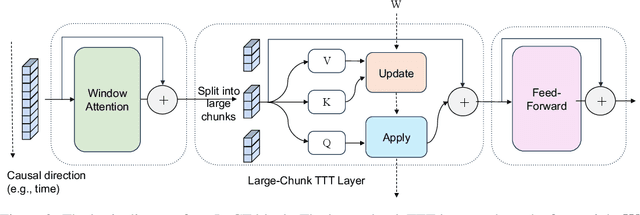
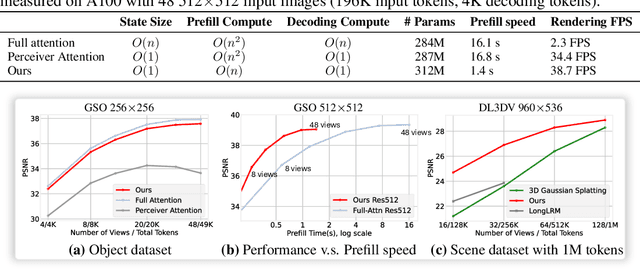
Abstract:Test-Time Training (TTT) models context dependencies by adapting part of the model's weights (referred to as fast weights) during inference. This fast weight, akin to recurrent states in RNNs, stores temporary memories of past tokens in the current sequence. Existing TTT methods struggled to show effectiveness in handling long-context data, due to their inefficiency on modern GPUs. The TTT layers in many of these approaches operate with extremely low FLOPs utilization (often <5%) because they deliberately apply small online minibatch sizes (e.g., updating fast weights every 16 or 64 tokens). Moreover, a small minibatch implies fine-grained block-wise causal dependencies in the data, unsuitable for data beyond 1D ordered sequences, like sets or N-dimensional grids such as images or videos. In contrast, we pursue the opposite direction by using an extremely large chunk update, ranging from 2K to 1M tokens across tasks of varying modalities, which we refer to as Large Chunk Test-Time Training (LaCT). It improves hardware utilization by orders of magnitude, and more importantly, facilitates scaling of nonlinear state size (up to 40% of model parameters), hence substantially improving state capacity, all without requiring cumbersome and error-prone kernel implementations. It also allows easy integration of sophisticated optimizers, e.g. Muon for online updates. We validate our approach across diverse modalities and tasks, including novel view synthesis with image set, language models, and auto-regressive video diffusion. Our approach can scale up to 14B-parameter AR video diffusion model on sequences up to 56K tokens. In our longest sequence experiment, we perform novel view synthesis with 1 million context length. We hope this work will inspire and accelerate new research in the field of long-context modeling and test-time training. Website: https://tianyuanzhang.com/projects/ttt-done-right
Eval3D: Interpretable and Fine-grained Evaluation for 3D Generation
Apr 25, 2025Abstract:Despite the unprecedented progress in the field of 3D generation, current systems still often fail to produce high-quality 3D assets that are visually appealing and geometrically and semantically consistent across multiple viewpoints. To effectively assess the quality of the generated 3D data, there is a need for a reliable 3D evaluation tool. Unfortunately, existing 3D evaluation metrics often overlook the geometric quality of generated assets or merely rely on black-box multimodal large language models for coarse assessment. In this paper, we introduce Eval3D, a fine-grained, interpretable evaluation tool that can faithfully evaluate the quality of generated 3D assets based on various distinct yet complementary criteria. Our key observation is that many desired properties of 3D generation, such as semantic and geometric consistency, can be effectively captured by measuring the consistency among various foundation models and tools. We thus leverage a diverse set of models and tools as probes to evaluate the inconsistency of generated 3D assets across different aspects. Compared to prior work, Eval3D provides pixel-wise measurement, enables accurate 3D spatial feedback, and aligns more closely with human judgments. We comprehensively evaluate existing 3D generation models using Eval3D and highlight the limitations and challenges of current models.
I-Con: A Unifying Framework for Representation Learning
Apr 23, 2025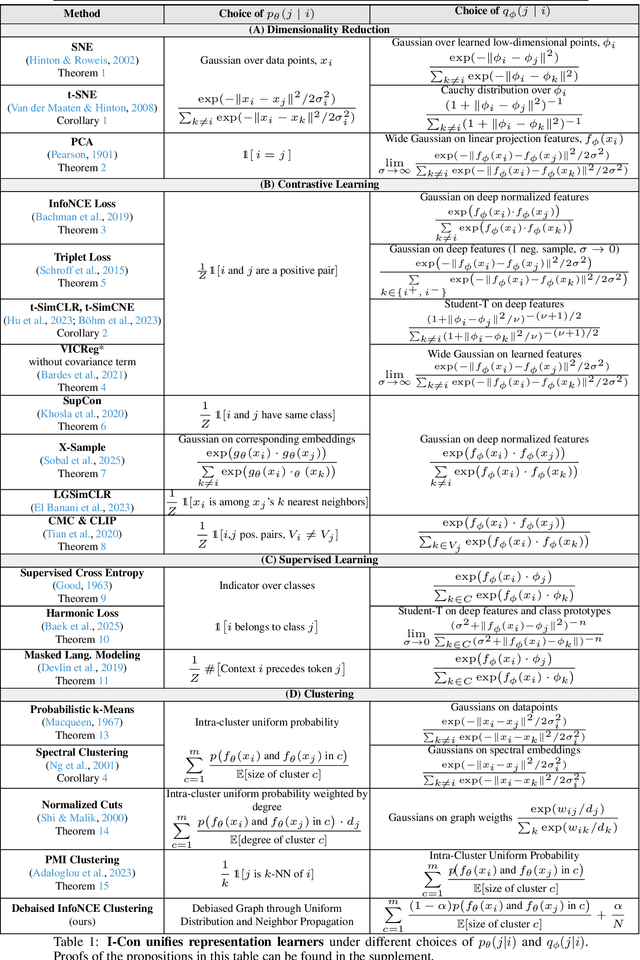
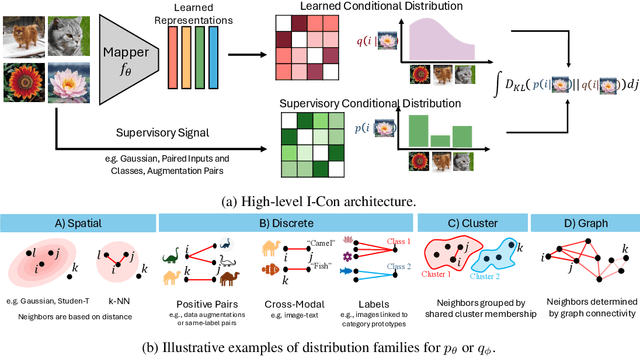

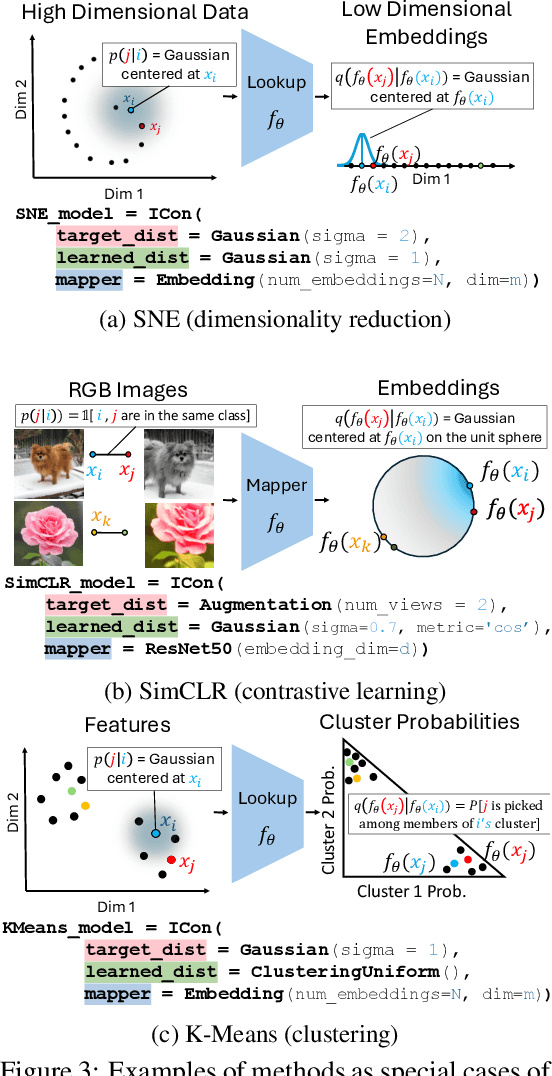
Abstract:As the field of representation learning grows, there has been a proliferation of different loss functions to solve different classes of problems. We introduce a single information-theoretic equation that generalizes a large collection of modern loss functions in machine learning. In particular, we introduce a framework that shows that several broad classes of machine learning methods are precisely minimizing an integrated KL divergence between two conditional distributions: the supervisory and learned representations. This viewpoint exposes a hidden information geometry underlying clustering, spectral methods, dimensionality reduction, contrastive learning, and supervised learning. This framework enables the development of new loss functions by combining successful techniques from across the literature. We not only present a wide array of proofs, connecting over 23 different approaches, but we also leverage these theoretical results to create state-of-the-art unsupervised image classifiers that achieve a +8% improvement over the prior state-of-the-art on unsupervised classification on ImageNet-1K. We also demonstrate that I-Con can be used to derive principled debiasing methods which improve contrastive representation learners.
Denoising Hamiltonian Network for Physical Reasoning
Mar 10, 2025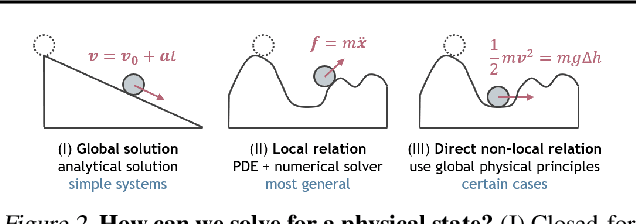
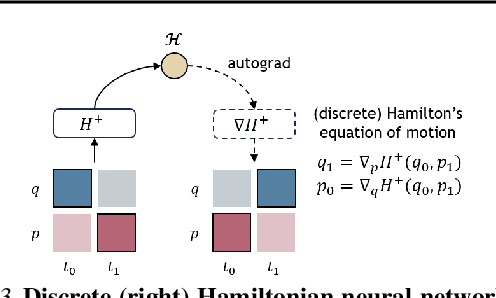
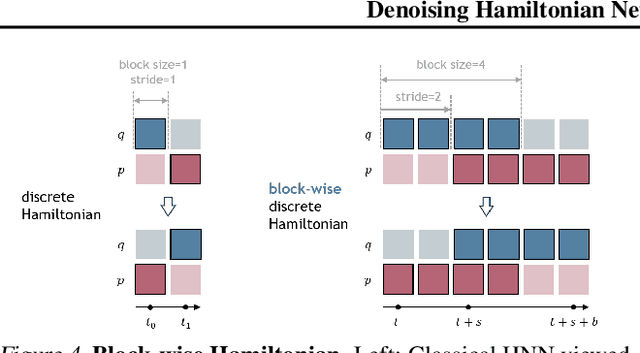

Abstract:Machine learning frameworks for physical problems must capture and enforce physical constraints that preserve the structure of dynamical systems. Many existing approaches achieve this by integrating physical operators into neural networks. While these methods offer theoretical guarantees, they face two key limitations: (i) they primarily model local relations between adjacent time steps, overlooking longer-range or higher-level physical interactions, and (ii) they focus on forward simulation while neglecting broader physical reasoning tasks. We propose the Denoising Hamiltonian Network (DHN), a novel framework that generalizes Hamiltonian mechanics operators into more flexible neural operators. DHN captures non-local temporal relationships and mitigates numerical integration errors through a denoising mechanism. DHN also supports multi-system modeling with a global conditioning mechanism. We demonstrate its effectiveness and flexibility across three diverse physical reasoning tasks with distinct inputs and outputs.
Measuring and Mitigating Hallucinations in Vision-Language Dataset Generation for Remote Sensing
Jan 24, 2025



Abstract:Vision language models have achieved impressive results across various fields. However, adoption in remote sensing remains limited, largely due to the scarcity of paired image-text data. To bridge this gap, synthetic caption generation has gained interest, traditionally relying on rule-based methods that use metadata or bounding boxes. While these approaches provide some description, they often lack the depth needed to capture complex wide-area scenes. Large language models (LLMs) offer a promising alternative for generating more descriptive captions, yet they can produce generic outputs and are prone to hallucination. In this paper, we propose a new method to enhance vision-language datasets for remote sensing by integrating maps as external data sources, enabling the generation of detailed, context-rich captions. Additionally, we present methods to measure and mitigate hallucinations in LLM-generated text. We introduce fMoW-mm, a multimodal dataset incorporating satellite imagery, maps, metadata, and text annotations. We demonstrate its effectiveness for automatic target recognition in few-shot settings, achieving superior performance compared to other vision-language remote sensing datasets.
CamCtrl3D: Single-Image Scene Exploration with Precise 3D Camera Control
Jan 10, 2025



Abstract:We propose a method for generating fly-through videos of a scene, from a single image and a given camera trajectory. We build upon an image-to-video latent diffusion model. We condition its UNet denoiser on the camera trajectory, using four techniques. (1) We condition the UNet's temporal blocks on raw camera extrinsics, similar to MotionCtrl. (2) We use images containing camera rays and directions, similar to CameraCtrl. (3) We reproject the initial image to subsequent frames and use the resulting video as a condition. (4) We use 2D<=>3D transformers to introduce a global 3D representation, which implicitly conditions on the camera poses. We combine all conditions in a ContolNet-style architecture. We then propose a metric that evaluates overall video quality and the ability to preserve details with view changes, which we use to analyze the trade-offs of individual and combined conditions. Finally, we identify an optimal combination of conditions. We calibrate camera positions in our datasets for scale consistency across scenes, and we train our scene exploration model, CamCtrl3D, demonstrating state-of-theart results.
Exoplanet Detection via Differentiable Rendering
Jan 03, 2025Abstract:Direct imaging of exoplanets is crucial for advancing our understanding of planetary systems beyond our solar system, but it faces significant challenges due to the high contrast between host stars and their planets. Wavefront aberrations introduce speckles in the telescope science images, which are patterns of diffracted starlight that can mimic the appearance of planets, complicating the detection of faint exoplanet signals. Traditional post-processing methods, operating primarily in the image intensity domain, do not integrate wavefront sensing data. These data, measured mainly for adaptive optics corrections, have been overlooked as a potential resource for post-processing, partly due to the challenge of the evolving nature of wavefront aberrations. In this paper, we present a differentiable rendering approach that leverages these wavefront sensing data to improve exoplanet detection. Our differentiable renderer models wave-based light propagation through a coronagraphic telescope system, allowing gradient-based optimization to significantly improve starlight subtraction and increase sensitivity to faint exoplanets. Simulation experiments based on the James Webb Space Telescope configuration demonstrate the effectiveness of our approach, achieving substantial improvements in contrast and planet detection limits. Our results showcase how the computational advancements enabled by differentiable rendering can revitalize previously underexploited wavefront data, opening new avenues for enhancing exoplanet imaging and characterization.
From Slow Bidirectional to Fast Causal Video Generators
Dec 10, 2024



Abstract:Current video diffusion models achieve impressive generation quality but struggle in interactive applications due to bidirectional attention dependencies. The generation of a single frame requires the model to process the entire sequence, including the future. We address this limitation by adapting a pretrained bidirectional diffusion transformer to a causal transformer that generates frames on-the-fly. To further reduce latency, we extend distribution matching distillation (DMD) to videos, distilling 50-step diffusion model into a 4-step generator. To enable stable and high-quality distillation, we introduce a student initialization scheme based on teacher's ODE trajectories, as well as an asymmetric distillation strategy that supervises a causal student model with a bidirectional teacher. This approach effectively mitigates error accumulation in autoregressive generation, allowing long-duration video synthesis despite training on short clips. Our model supports fast streaming generation of high quality videos at 9.4 FPS on a single GPU thanks to KV caching. Our approach also enables streaming video-to-video translation, image-to-video, and dynamic prompting in a zero-shot manner. We will release the code based on an open-source model in the future.
 Add to Chrome
Add to Chrome Add to Firefox
Add to Firefox Add to Edge
Add to Edge